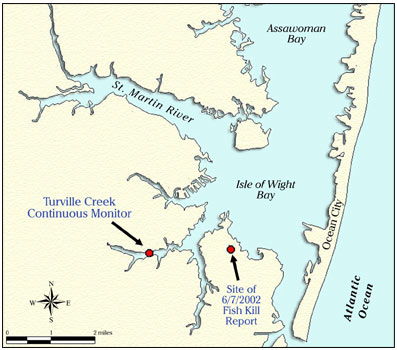 Print This Page
Print This Page Print This Page
Print This Page |
Isle of Wight Fish Kill Cause Determined With
Continuous Monitoring Data
On June 7th, 2002, a fish kill of 15,000 menhaden was reported in the canals
of Cape Isle of Wight in the Maryland Coastal Bays. A nearby continuous monitor
in Turville Creek showed that low dissolved oxygen of <1 mg/l on the morning
of June 6th, caused by an algal bloom die-off several days prior, was the likely
cause of the fish kill. The continuous monitoring data helped to pinpoint the
cause of the kill in a timely manner and rule out the possibility of a toxic
Pfiesteria outbreak. Quickly determining causes of fish kills in the coastal
bays is very important, given the economic importance and the human health ramifications
in and around the Ocean City, MD resort area.

